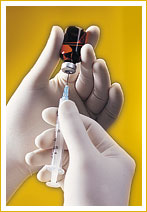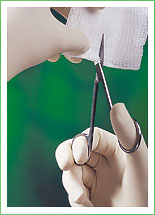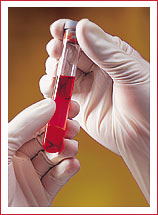Disposable Gloves FAQ
Q. Do your gloves comply with the USDA requirements for safe use in food handling?
A. Yes. Adenna gloves are safe to use in all parts of the food industry for food preparation and handling procedures. The USDA does not establish any official regulatory requirement for approval of gloves, but follows the guidelines of the FDA's specifications. Adenna exam gloves, which are made in compliance with the FDA and the Federal Food, Drug and Cosmetic Act (FFDCA), are therefore safe for preparing, washing and processing meat, poultry, seafood, vegetables, desserts, beverages, etc in all USDA inspected establishments.

Q. Why do some gloves produce brown stains when you put them on?
A. This is usually caused by the chemical reaction between your skin and the gloves. Before putting on gloves, your hands might come in contact with copper, iron or metal material, such as coins, or you may have acidic perspiration on your hands. This can usually cause brown stains when wearing gloves. These brown stains do not affect the barrier properties of gloves.
A. This is usually caused by the chemical reaction between your skin and the gloves. Before putting on gloves, your hands might come in contact with copper, iron or metal material, such as coins, or you may have acidic perspiration on your hands. This can usually cause brown stains when wearing gloves. These brown stains do not affect the barrier properties of gloves.
Q. Can I use hand lotion under latex gloves?
A. It is recommended to use hand lotion in between or after glove use only. However, if you do choose to use a cream or lotion before wearing gloves, choose one that is water-based, not petroleum or oil-based. Oil-based creams and lotions can deteriorate the barrier properties of the gloves.
A. It is recommended to use hand lotion in between or after glove use only. However, if you do choose to use a cream or lotion before wearing gloves, choose one that is water-based, not petroleum or oil-based. Oil-based creams and lotions can deteriorate the barrier properties of the gloves.
Q. How can you tell if a glove has degraded and should not be used?
A. A glove may have degraded when it turns hard or brittle and loses its elasticity. A glove that is too soft and does not return into shape after being stretched could also be too degraded for use. Change of color in the glove should also be a warning sign. DO NOT use gloves that show signs of degradation. Always follow our guidelines in storing gloves to preserve their shelf life, and rotate stock by practicing FIFO , "First-in First-out" inventory control.
In addition, use gloves prior to their expiration date. The FDA has proposed to glove manufacturers to add expiration dates to their glove products. Our gloves are marked with expiration dates on both dispensing boxes and outer cartons of all our gloves.
A. A glove may have degraded when it turns hard or brittle and loses its elasticity. A glove that is too soft and does not return into shape after being stretched could also be too degraded for use. Change of color in the glove should also be a warning sign. DO NOT use gloves that show signs of degradation. Always follow our guidelines in storing gloves to preserve their shelf life, and rotate stock by practicing FIFO , "First-in First-out" inventory control.
In addition, use gloves prior to their expiration date. The FDA has proposed to glove manufacturers to add expiration dates to their glove products. Our gloves are marked with expiration dates on both dispensing boxes and outer cartons of all our gloves.
Q. What are the storage guidelines for your gloves?
A. Always store our gloves in the original packaging in a cool, dry and well ventilated area. Keep gloves away and protected from dust, sunlight, moisture, X-ray, and excessive heat above 100 F (37°C).
A. Always store our gloves in the original packaging in a cool, dry and well ventilated area. Keep gloves away and protected from dust, sunlight, moisture, X-ray, and excessive heat above 100 F (37°C).
Q. Several of my coworkers have latex allergies, what should I know about this and what alternatives can I offer?
A. In the 1990s, latex allergies emerged as a serious medical issue. Allergy symptoms range from discomfort in the hands or allergic reactions when wearing or after wearing latex or plastic gloves. There are many products that contain latex and could cause reactions ranging from dry, itchy, crusty skin with cracks or sores, to a runny nose, wheezing, difficulty breathing, swelling in the face, cramps and shock. Rare cases can even be potentially life threatening. However, the exact cause of latex allergies is still unknown. Researchers are also unable to determine the exact level of latex protein, or the length of time an individual needs to be exposed to become allergic. Because it is possible to develop an allergy to latex, it is important to offer non-latex options. We offer latex-free synthetic vinyl gloves in a variety of styles and sizes.
A. In the 1990s, latex allergies emerged as a serious medical issue. Allergy symptoms range from discomfort in the hands or allergic reactions when wearing or after wearing latex or plastic gloves. There are many products that contain latex and could cause reactions ranging from dry, itchy, crusty skin with cracks or sores, to a runny nose, wheezing, difficulty breathing, swelling in the face, cramps and shock. Rare cases can even be potentially life threatening. However, the exact cause of latex allergies is still unknown. Researchers are also unable to determine the exact level of latex protein, or the length of time an individual needs to be exposed to become allergic. Because it is possible to develop an allergy to latex, it is important to offer non-latex options. We offer latex-free synthetic vinyl gloves in a variety of styles and sizes.

Q. What are the different types of hypersensitivity?
A. The adverse reactions associated with natural rubber latex affecting some individuals can be classified into the following three types:
A. The adverse reactions associated with natural rubber latex affecting some individuals can be classified into the following three types:
| Reaction Type | Symptoms | Possible Cause |
| Irritant Contact Dermatitis (non-allergic) | Rash, dry flaky skin with papules, cracks and sores | Too frequent hand washing, glove powder, detergents and soaps used in washing hands |
| Type IV - Chemical protein hypersensitivity (IgE mediated allergy) | Eczema, itching or inflammation of skin, formation of scales, 48 to 96 hours after contact | Residuals of chemicals used in processing of gloves |
| Type I - Latex protein hypersensitivity (IgE mediated allergy) | Immmediate localized itching, burning and discomfort, hives within 5 to 60 minutes after exposure, rhinitis, asthma and in serious cases, anaphylactic shock and in rare cases, death. | Residual extractable protein in natural rubber latex products |
Q. Are gloves that have "hypoallergenic" claim safe for everyone?
A. No, the FDA has ruled and required that the labeling of "hypoallergenic" be removed from all glove packaging effective on September 30, 1998. The FDA has received reports of allergic reactions to medical gloves labeled as "hypoallergenic". The FDA believes that "hypoallergenic" labeling on devices that contain natural rubber latex is misleading, as it incorrectly implies that such devices may be used safely by individuals who are sensitive to natural latex protein.
A. No, the FDA has ruled and required that the labeling of "hypoallergenic" be removed from all glove packaging effective on September 30, 1998. The FDA has received reports of allergic reactions to medical gloves labeled as "hypoallergenic". The FDA believes that "hypoallergenic" labeling on devices that contain natural rubber latex is misleading, as it incorrectly implies that such devices may be used safely by individuals who are sensitive to natural latex protein.
Q. Who is at risk?
A. Latex allergies, which emerged as a medical concern in the early 90's, affects approximately 2 -3% of general population in the United States, including up to 10% of health care workers. Those at higher risk for developing an allergy include healthcare workers, children and individuals with spina bifida, persons with multiple operations and certain industry workers, such as those in the rubber industry.
A. Latex allergies, which emerged as a medical concern in the early 90's, affects approximately 2 -3% of general population in the United States, including up to 10% of health care workers. Those at higher risk for developing an allergy include healthcare workers, children and individuals with spina bifida, persons with multiple operations and certain industry workers, such as those in the rubber industry.
Q. How can I prevent and protect myself and others from latex allergy?
A. All patients should be questioned about a history of latex allergies when being admitted. A history suggestive of reactions to latex may include any symptoms suffered from contact with rubber products. Patients who have latex allergy or patients with spina bifida, regardless of their history, should be treated in a latex free environment. It is also helpful to learn the symptoms of a latex allergy, to warn others about you or another's allergy and to reduce your contact with latex products by substituting with vinyl and other synthetic gloves when possible.
A. All patients should be questioned about a history of latex allergies when being admitted. A history suggestive of reactions to latex may include any symptoms suffered from contact with rubber products. Patients who have latex allergy or patients with spina bifida, regardless of their history, should be treated in a latex free environment. It is also helpful to learn the symptoms of a latex allergy, to warn others about you or another's allergy and to reduce your contact with latex products by substituting with vinyl and other synthetic gloves when possible.

Q. What about glove powders and proteins?
A. While even powder free gloves cannot be completely 100% free of powder due to the manufacturing process, seriously limiting your exposure to powder, particularly in latex gloves, could significantly decrease your risk of developing an allergy.
A. While even powder free gloves cannot be completely 100% free of powder due to the manufacturing process, seriously limiting your exposure to powder, particularly in latex gloves, could significantly decrease your risk of developing an allergy.
Q. How do synthetic gloves perform compared to latex?
A. Though gloves vary by brand, generally latex gloves are the best fitting and most durable of gloves available. However, some situations and circumstances require non-latex gloves. There are suitable alternatives including vinyl and nitrile gloves. These gloves offer good protection, and are designed to fit the hand comfortably. However, some of these gloves can be punctured more easily than latex and may not provide as good of a barrier as latex. They will also generally fit a more loosly. However, oil-based substances will deteriorate latex, so non-latex gloves are a good option in these situations.
A. Though gloves vary by brand, generally latex gloves are the best fitting and most durable of gloves available. However, some situations and circumstances require non-latex gloves. There are suitable alternatives including vinyl and nitrile gloves. These gloves offer good protection, and are designed to fit the hand comfortably. However, some of these gloves can be punctured more easily than latex and may not provide as good of a barrier as latex. They will also generally fit a more loosly. However, oil-based substances will deteriorate latex, so non-latex gloves are a good option in these situations.
Q. What is a chlorination process in manufacturing gloves?
A. Chlorination is a process where chlorine, ammonia, water and other chemicals are used in the manufacturing of gloves. Adenna Gold Latex Powder Free Exam Gloves are manufactured with a proprietary single chlorination process. This process removes powder and breaks down latex protein as well as chemical residue on or near the glove surface.
A. Chlorination is a process where chlorine, ammonia, water and other chemicals are used in the manufacturing of gloves. Adenna Gold Latex Powder Free Exam Gloves are manufactured with a proprietary single chlorination process. This process removes powder and breaks down latex protein as well as chemical residue on or near the glove surface.

Q. How are your chlorinated gloves different from others?
A. A poor chlorination process (including over-chlorination) can result in gloves that are brittle and weak, tear easily, and have dark yellow or brown discoloring. Sometimes the gloves can be very sticky and make donning impossible; or be very slippery without grip on the surface. Poor chlorination also produces gloves that have a strong chlorine odor.
A. A poor chlorination process (including over-chlorination) can result in gloves that are brittle and weak, tear easily, and have dark yellow or brown discoloring. Sometimes the gloves can be very sticky and make donning impossible; or be very slippery without grip on the surface. Poor chlorination also produces gloves that have a strong chlorine odor.




